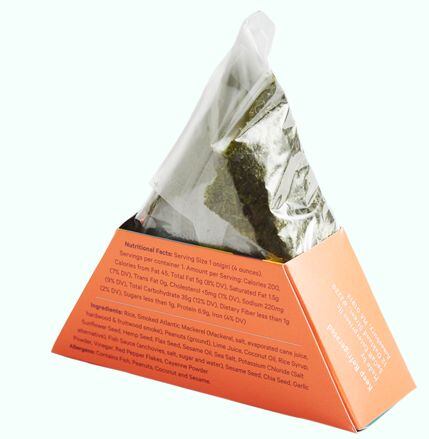Wrapped in two layers of cellophane - so the rice and nori only come in contact when the consumer unwraps it, ensuring the nori remains crisp and crunchy - yusō snacks contain 180-200 calories and are surprisingly satisfying, says Sturtevant, a former equity analyst who discovered onigiri on a business trip to Japan and immediately felt her entrepreneurial juices flowing.
“I was traveling and we were too busy to stop at a restaurant so the person I was with grabbed a whole bunch of onigiri from a convenience store and said just trust me, you’re going to like these.”
Hooked on the first bite, Sturtevant started doing some research, and learned that onigiri were beginning to pick up steam in some US restaurants, small bakeries and food trucks, although the cellophane wrapped version she enjoyed in Japan was not something US consumers were familiar with (with the exception of Hawaii), despite its popularity in Asia and many parts of Europe.
With one bite you’re getting all of these wonderful flavors and textures
So she quit the day job in 2014 and started work on formulating her own versions, which are Japanese inspired, but with an American twist, containing hemp, flax, chia, sunflower and sesame seeds, and red pepper flakes, says Sturtevant, who has secured seed capital from five angel investors to get the business off the ground.
“I wanted to bring down the sodium as I was kind of shocked by how much salt was in the Japanese versions. But I’ve also got a mixture of flavors, a global fusion, so we have a Vietnamese sriracha sauce in one product, a Thai peanut sauce in another, and a spicy chickpea and sesame seed filling, not something you’d see in Japan.”
The texture is also unusual, she says: “The first bite, you get the crunch of the nori, which is new, because usually if you have nori on a California roll the moisture of the rice has already permeated the nori making it kind of chewy, but my nori is crunchy and crispy. Then you get the chewy savoryness of the rice, and then you get the surprise in the middle – smoked Atlantic mackerel, Norwegian smoked steelhead, Icelandic smoked Atlantic salmon, or chickpeas.
“And then you’ve got hemp, flax and chia seeds, and all these spicy flavors, so with one bite you’re getting all of these wonderful flavors and textures.”
In Europe, you see them next to the prepared sandwiches
So where is the best place to merchandise the snacks, which have a short shelf life (five days)?
“In Europe, you see them next to the prepared sandwiches,” says Sturtevant, who manufactures the product in-house in Amesbury Mass, in part because proprietary kit is involved.
“But you could also put them next to sushi, smoothies, fresh snacks and at the deli counter. Yes, five days is not very long and of course retailers would like more, but it’s a fresh product, and if you’re buying sandwiches or wraps, you’re looking at the same kind of shelf-life. But a fresh snack is still a relatively new concept in the industry – when you think snacks, you think shelf stable.
“When we demo it consumers also love the fact that it’s got no artificial preservatives or colorings or additives plus the fact that it’s gluten-free, non-GMO and so on.”
A fresh snack is still a relatively new concept in the industry
So who’s the target consumer?
Sushi fans are an obvious target, but Millennials looking for bold new spicy snacks are also enthusiastic about the product, says Sturtevant, who conducted focus groups before launch that provided some great feedback.
“The concept has already been proven in other markets but we wanted to find out if it would work here, and what consumers are looking for, especially when it comes to fish, where sustainability is very important.
“We also discussed usage occasions. It’s also surprisingly filling, so people enjoy it at lunch or mid-afternoon. A lot of students also said they’d eat it during a late study session instead of candy.”

Spicy smoked steelhead yusō ingredients: Rice, Smoked Steelhead (Steelhead, salt, sugar, natural wood smoke), Coconut Oil, Sunflower Seed, Hemp Seed, Flax Seed, Sesame Oil, Sea Salt, Potassium Chloride, Lime Juice, Sesame Seed, Chia Seed, Rice Syrup, Garlic Powder, Ginger Powder, Vinegar, Red Pepper Flakes, Cayenne Powder.
Lunchtime, mid-afternoon snack, late night snack
The brand name – yusō – is the Japanese word for transport, which makes sense as the snack is portable, but is also short and fun, says Sturtevant. “I worked with a marketing firm to develop the look and this just worked best.”
Right now, Sturtevant is focused on building traction in independent stores in the Massachusetts area after a soft launch in September, but says longer term she could see the product anywhere with a refrigerator, from large grocery chains keen to build out their fresh food offer to coffee chains looking for something new and distinctive to add to their chillers.
What are the emerging trends in snacks?

From sprouted mung beans to Japanese-inspired onigiri, the snacks market is a hotbed of innovation. But what’s next? Hear from Peeled Snacks, Dang Foods, Field Trip Jerky, Protes and board advisor and guru Brad Barnhorn at our FREE-to-attend online Snacking Innovation Summit on Feb 15.

